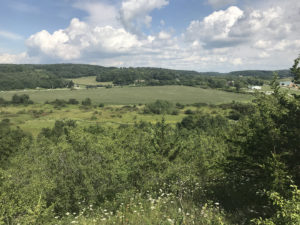by Gary Werner, Volunteer, and Kevin Thusius, Director of Land Conservation, Ice Age Trail Alliance

Photo Credit: Kevin Thusius, IATA
The view from atop one of the Ice Age Trail Alliance’s most recent land purchases, “Mammoth’s Back,” looking over Black Earth Creek in Wisconsin, where just beyond the great ice sheet stopped and retreated.
Over the past year or so, the Ice Age Trail Alliance (IATA), Dane County, and the City of Madison have collectively purchased 86 acres of land and conservation and trail right-of-way easements covering an additional 152 acres along the Ice Age National Scenic Trail. Each of these three land purchases closes an approximately half-mile long gap in the trail while preserving up to a half-mile wide corridor along the trail in the heart of Dane County, home to over 600,000 people and Wisconsin’s fastest growing county. Meanwhile, Groundswell Conservancy, a local regional land trust, purchased another five acres protecting part of the view shed of the trail.
Each of these conservation purchases helped to implement the “Ice Age National Scenic Trail Corridor Protection Plan for Dane County,” adopted in 1992 by the National Park Service, Wisconsin Department of Natural Resources, and the Dane County Board of Supervisors. The plan authorizes local and State government to permanently preserve land along the adopted alignment of the Ice Age National Scenic Trail. The City of Madison has incorporated sections of the planned trail corridor in its master plan.
The land purchase by the IATA was funded with money from the Wisconsin Stewardship Fund, the Dane County Conservation Fund, and donations from dozens of individuals. Dane County also provided some funding for the land purchased by Madison.
Besides closing gaps in the Ice Age Trail otherwise threatened to be permanent by residential development, the three purchases also preserve rare native ecosystems and geological features. The land purchased by the IATA includes a solitary hill—called “Mammoth’s Back”—that preserves a native short grass prairie remnant, an island in a sea of agriculture. This land also buffers wetlands and a stretch of Black Earth Creek, a nationally renowned trout stream, already protected earlier by the IATA. Madison’s 40-acre parcel is mostly old growth oak forest, one of the larger patches of such woodland in the highly fragmented landscape of Dane County.
In addition to providing a half-mile long right-of-way easement for the Ice Age Trail, Dane County’s conservation easement covering a quarter section of land prevents residential development and protects the rural character of the landscape. The easement also protects a pond surrounded by wetland just beyond the moraine, marking the furthest advance of the Wisconsin glaciation. This wetland and pond complement a similar nearby pond in the U.S. Fish and Wildlife Service’s Shoveler Sink Waterfowl Protection Area. Both of these areas are part of the 1,700-acre Cross Plains Ice Age National Scientific Reserve.
There is great power, potential, and inspiring success in these partnerships between local, State, and Federal governments and private individuals and organizations persistently working together to preserve and enhance the Ice Age National Scenic Trail. Much like the inexorably moving glaciers that not so long ago sculpted the landscape of southern Wisconsin, the persistence of these partners is piece-by-piece preserving a landscape of learning and delight for those who walk the trail just minutes from Wisconsin’s capital.
Unless otherwise indicated, all material in Pathways Across America is public domain. All views expressed herein are perspectives of individuals working on behalf of the National Trails System and do not necessarily represent the viewpoint of the Federal agencies.